More Posts from Aspergers1044 and Others
Different Types of Supernovae are the Primary Origins of Different Classes of Chemical_Elements.
You Are Made of Stardust
Though the billions of people on Earth may come from different areas, we share a common heritage: we are all made of stardust! From the carbon in our DNA to the calcium in our bones, nearly all of the elements in our bodies were forged in the fiery hearts and death throes of stars.
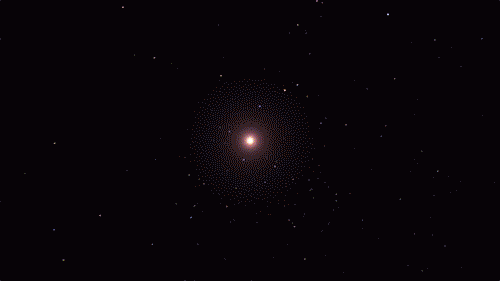
The building blocks for humans, and even our planet, wouldn’t exist if it weren’t for stars. If we could rewind the universe back almost to the very beginning, we would just see a sea of hydrogen, helium, and a tiny bit of lithium.
The first generation of stars formed from this material. There’s so much heat and pressure in a star’s core that they can fuse atoms together, forming new elements. Our DNA is made up of carbon, hydrogen, oxygen, nitrogen, and phosphorus. All those elements (except hydrogen, which has existed since shortly after the big bang) are made by stars and released into the cosmos when the stars die.

Each star comes with a limited fuel supply. When a medium-mass star runs out of fuel, it will swell up and shrug off its outer layers. Only a small, hot core called a white dwarf is left behind. The star’s cast-off debris includes elements like carbon and nitrogen. It expands out into the cosmos, possibly destined to be recycled into later generations of stars and planets. New life may be born from the ashes of stars.
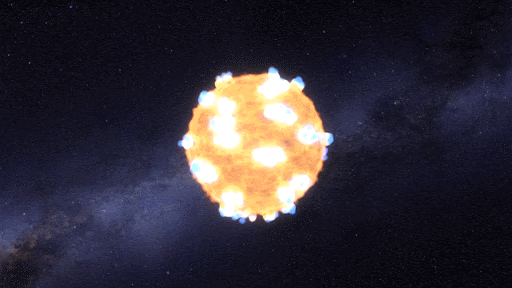
Massive stars are doomed to a more violent fate. For most of their lives, stars are balanced between the outward pressure created by nuclear fusion and the inward pull of gravity. When a massive star runs out of fuel and its nuclear processes die down, it completely throws the star out of balance. The result? An explosion!
Supernova explosions create such intense conditions that even more elements can form. The oxygen we breathe and essential minerals like magnesium and potassium are flung into space by these supernovas.
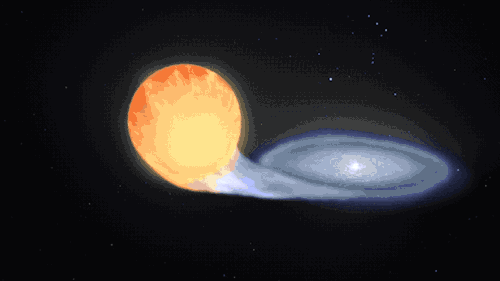
Supernovas can also occur another way in binary, or double-star, systems. When a white dwarf steals material from its companion, it can throw everything off balance too and lead to another kind of cataclysmic supernova. Our Nancy Grace Roman Space Telescope will study these stellar explosions to figure out what’s speeding up the universe’s expansion.
This kind of explosion creates calcium – the mineral we need most in our bodies – and trace minerals that we only need a little of, like zinc and manganese. It also produces iron, which is found in our blood and also makes up the bulk of our planet’s mass!

A supernova will either leave behind a black hole or a neutron star – the superdense core of an exploded star. When two neutron stars collide, it showers the cosmos in elements like silver, gold, iodine, uranium, and plutonium.

Some elements only come from stars indirectly. Cosmic rays are nuclei (the central parts of atoms) that have been boosted to high speed by the most energetic events in the universe. When they collide with atoms, the impact can break them apart, forming simpler elements. That’s how we get boron and beryllium – from breaking star-made atoms into smaller ones.
Half a dozen other elements are created by radioactive decay. Some elements are radioactive, which means their nuclei are unstable. They naturally break down to form simpler elements by emitting radiation and particles. That’s how we get elements like radium. The rest are made by humans in labs by slamming atoms of lighter elements together at super high speeds to form heavier ones. We can fuse together elements made by stars to create exotic, short-lived elements like seaborgium and einsteinium.
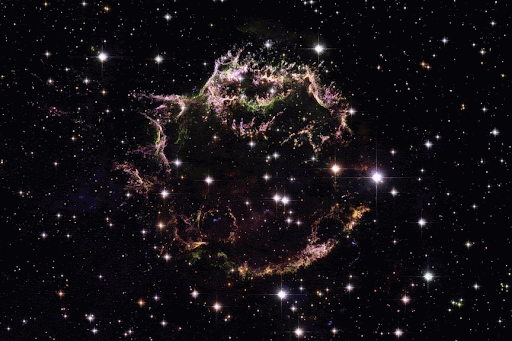
From some of the most cataclysmic events in the cosmos comes all of the beauty we see here on Earth. Life, and even our planet, wouldn’t have formed without them! But we still have lots of questions about these stellar factories.
In 2006, our Stardust spacecraft returned to Earth containing tiny particles of interstellar dust that originated in distant stars, light-years away – the first star dust to ever be collected from space and returned for study. You can help us identify and study the composition of these tiny, elusive particles through our Stardust@Home Citizen Science project.
Our upcoming Roman Space Telescope will help us learn more about how elements were created and distributed throughout galaxies, all while exploring many other cosmic questions. Learn more about the exciting science this mission will investigate on Twitter and Facebook.
Make sure to follow us on Tumblr for your regular dose of space!
I Support The Use of Solar_Energy for The Generation of Electricity.
Donald Trump is trying to destroy solar energy in America.
As someone who has been using 100% solar energy to power everything but my apartment and car for nearly eight months, and frequently has too much energy and too little storage, I feel the need to comment on this.
So Trump put a 30% tariff on importing materials used to manufacture solar panels. More than 50% of the world’s silicon production (the element that best allows for the photovoltaic effect) is in China, whereas less than 5% of production is in the US. Not to mention other imported materials needed to make solar panels.
Before anyone says “then why don’t we just make this stuff in America,” we do, but in very small quantities, because the resources to create these materials are scarce in North America. It’s called GEOpolitics for a reason.
So, higher tariffs on imported materials required to manufacture solar panels means fewer American companies will be purchasing foreign materials, because foreign materials will be jump in cost to account for the tariffs. The countries trading the materials will also trade less material so as not to incur these tariffs at their own expense, which could stem the flow imported goods to a trickle. These same countries will begin trading with other countries that don’t have as high a tariff and whose governments actually encourage renewable energy and solar production (unlike, obviously, the shitty assholes in our government whose paychecks come from the Koch Brothers and Big Oil, all of who don’t give a damn, because only socialist countries use renewable energy, afterall).
More solar production in America = less cost to consumers (free energy for immediate purchasers and long-term users)
More production = overproduction
Overproduction = manufacturing and innovating better storage
Better storage = longer usage, more energy to drive more industry and innovation in technology
More industry and technology + cheap/free energy = more money in individual pockets, more job creation, boost in economy
Boost in economy + more money to individuals + high skill job creation = better education and rise in quality of life for lower and middle classes
Better education and rise in quality of life = better social values and more intelligent citizens entering workforce and entreprenurial sector.
So why discourage solar production? Why not lead the charge and prioritize solar production, instead of speaking out against it and making it more difficult to obtain solar in America? Why not make it more difficult to import oil to encourage a transition to cleaner, more reliable, and cheaper if not FREE energy? Why?
Transitioning to solar and renewable energy should absolutely be one of the highest priorities for our government, but it’s not. We have all these individual companies and cities saying they’ll phase out coal and oil and go all electric and renewable, and you’re going to see an increase in profits, an increase in the quality of life in those cities, better income, and more innovation. Oil companies know this is happening – and they are going to fight as brutally as a wounded animal, and they will fund campaigns of people who support coal and oil, even though they are dying.
Yes, oil isn’t just used as fuel. It’s in clothes, and soaps, and ink, and whatever else. Obviously. That’s completely beside the point. Because our transportation is the #1 source of our carbon emissions. We have heat islands in cities for a reason. You wouldn’t breathe in a tailpipe FOR A REASON. If we could completely eliminate transportation emissions in the next 10 years, and household and structure emissions in the next 20, why isn’t the government even voicing support for that? The government doesn’t have to regulate everything and lead the charge, but Trump and his cronies literally and forcefully OPPOSE renewable energy.
I have six solar panels and three large battery packs. I have been using these for eight months. Five hours of sunlight gives me more than a week’s worth of energy to use. If I had the resources to store ALL of the energy I could generate per day, I would be able to generate about two weeks of energy in a SINGLE DAY. In one week, I would have enough energy to use for more than six months. So don’t tell me solar doesn’t work. Don’t me it’s bad on a cloudy day, or during snowstorms, or at night, or when it’s raining. I have gone nearly two weeks without sunlight and been completely fine. Mine are just the small scale. I haven’t even used a wall plug for anything but my computer in eight months (and computer is just emergencies). But I don’t even put them out every day, because I just don’t have the storage capacity for the energy I *could* generate. Solar works. Solar is infinitely better than coal and oil ever will be. We need to be funding it. We need to be pushing ahead with it. We can’t be punishing it just to cling to some outdated way of thinking. If you claim to want a better America (let’s be real, Trump doesn’t give one single shit), you need to understand #1 that we NEED these materials and #2 they don’t magically appear in the ground where you put your shovel. The rest of the world, ESPECIALLY CHINA, for god’s sake, is pushing ahead with developing solar infrastructures. So why aren’t we even trying? And “because it’s not the government’s job” isn’t an excuse. Know why? Because the Donald Trump and the government is SUPPRESSING it.

This could be The First Confirmed Astronomical Discovery of an Extrasolar_Moon more than 20_Years after The First Confirmed Astronomical Discovery of an Extrasolar_Planet was made!
I would sure like to see something like The Hyperloop or Evacuated Tube Technology come to be a common form of Long-Distance Travel someday!

MIT Reveals its Version of Hyperloop Transit Pod
Tired of being stuck in traffic on the highway or waiting endlessly for a delayed subway? Almost three years ago, Elon Musk envisioned the Hyperloop, a new type of public transit that would whisk commuter-filled pods efficiently across hundreds of kilometers in a matter of minutes via tubes; and of course, only second to teleportation in terms of overall coolness.
Among a number of startups trying to get in on the competition sponsored by Musk’s company SpaceX, a student team from the Massachusetts Institute of Technology emerged earlier this year as the front-runner when it won the competition’s design phase. On Friday, MIT finally unveiled the prototype pod that it will test this summer at a 1-mile racetrack near SpaceX’s headquarters in Hawthorne, California.
Photograph by MIT
Extrasolar Planets - Nancy Kiang, NASA Goddard Institute for Space Studies.
Extraterrestrial Photosynthesis.
A Presentation on The Colors of Plants on various different Habitable Moons and Habitable Planets in different kinds of Solar_Systems throughout The Universe.
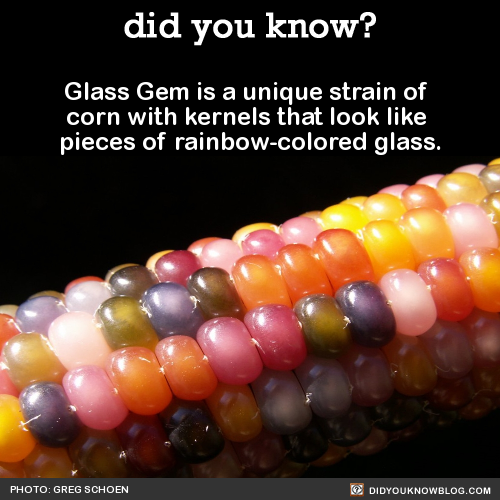
Glass Gem is a unique strain of corn with kernels that look like pieces of rainbow-colored glass. Source

Carl Barnes, an Oklahoma farmer, started growing older corn varieties to connect with his Cherokee heritage.


He isolated ancestral strains Native American tribes lost in the 1800s when they were relocated to Oklahoma.


Soon he began exchanging ancient corn seed with growers from all over the country, while simultaneously saving and replanting seeds from the most colorful cobs.

This eventually resulted in rainbow-colored corn.

When the rainbow corn mixed with the traditional varieties it created new strains, displaying more vibrant colors and patterns over time.


Glass Gem is a flint corn, so it isn’t really eaten off the cob. It’s usually ground into cornmeal and used in tortillas or grits, but it can also be used to make popcorn.

If you love corn and rainbows, seeds can be purchased online for about $7.95.

This is The Smallest Sized EXOPLANET Discovered by NASA's TRANSITING EXOPLANET SURVEY SATELLITE so far!
NASA's TESS mission finds its smallest planet yet
NASA’s Transiting Exoplanet Survey Satellite (TESS) has discovered a world between the sizes of Mars and Earth orbiting a bright, cool, nearby star. The planet, called L 98-59b, marks the tiniest discovered by TESS to date.

Two other worlds orbit the same star. While all three planets’ sizes are known, further study with other telescopes will be needed to determine if they have atmospheres and, if so, which gases are present. The L 98-59 worlds nearly double the number of small exoplanets – that is, planets beyond our solar system – that have the best potential for this kind of follow-up.
“The discovery is a great engineering and scientific accomplishment for TESS,” said Veselin Kostov, an astrophysicist at NASA’s Goddard Space Flight Center in Greenbelt, Maryland, and the SETI Institute in Mountain View, California. “For atmospheric studies of small planets, you need short orbits around bright stars, but such planets are difficult to detect. This system has the potential for fascinating future studies.”
A paper on the findings, led by Kostov, was published in the June 27 issue of The Astronomical Journal.
Keep reading
Nice Scenery!

Blanes, Catalunya -S Amazing World beautiful things
Climate Changes can possibly harm Human Health.

Excerpt:
Climate change is already making people sicker, according to a deep-dive written by Renee Cho for Columbia University’s Earth Institute on Monday.
Cho pointed to the example of doctors in Florida who are noticing that their patients run through prescriptions faster as conditions like asthma worsen due to heat waves.
Indeed, Florida doctors have observed enough instances of climate-related health issues that they’ve banded together to form Florida Clinicians for Climate Action, The Miami Herald reported in February.
“Being in Florida especially, you can’t not realize what’s happening to our climate. I see it right now on a day-to-day basis,” Dr. Cheryl Holder, president of the Florida State Medical Association, told The Herald.
Florida doctors have also noticed that heat waves coincide with more hospital visits due to heart failure, Florida Institute for Health Innovation head Roderick King told The Herald. He hopes to fund a study investigating the link.
In the Earth Institute article, Cho also mentioned the spread of diseases like Lyme disease, which have sickened people in Pennsylvania for the first time.
Cho’s analysis comes a week after an article published in Undark examining the spread of Lyme disease into Canada, where there were more than six times the number of Lyme disease cases reported in 2016 compared to 2009.
I sure would like to see this new Propulsion Technology in use for Interplanetary Travel someday!
Channeling Star Trek: Researchers to Begin Fusion Impulse Engine Experiments

by Michael Keller
Star Trek fans take note: Have a seat before you read the next sentence or prepare to swoon.
University of Alabama-Huntsville (UAH) aerospace engineers working with NASA, Boeing and Oak Ridge National Laboratory are investigating how to build fusion impulse rocket engines for extremely high-speed space travel.
“Star Trek fans love it, especially when we call the concept an impulse drive, which is what it is,” says team member Ross Cortez, an aerospace engineering Ph.D. candidate at UAH’s Aerophysics Research Center.
Stay seated Trekkies, because there’s more.
Keep reading
-
 aspergers1044 reblogged this · 9 years ago
aspergers1044 reblogged this · 9 years ago
